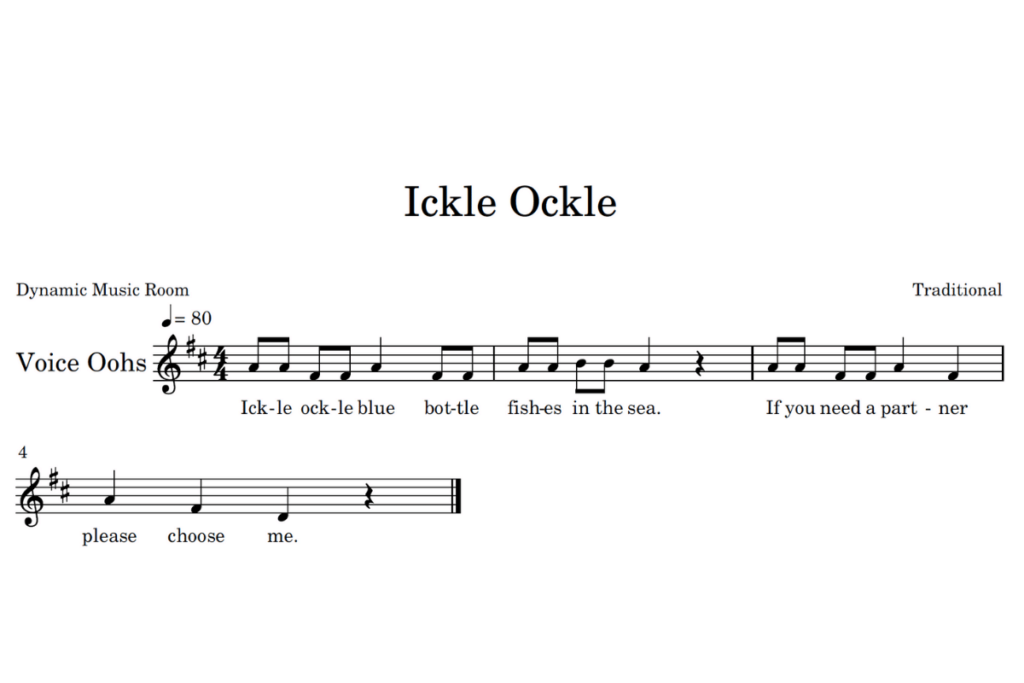As one of my go-to songs, it doesn’t get much better than the Scottish/English folk song, Ickle Ockle Blue Bottle.
It’s a simple song and perfect for teaching several key beginner concepts including, steady beat, sol-mi-la, and sol-mi-do while also having a pretty fun game.
Let’s get into the sheet music, game, and sample lessons to use with this fun song.

Save time with these 60 FREE Music Resources to use in your room right away!
Stop searching the whole internet to find good activities. I’ll help you cut to the chase with my favorite 60 FREE resources.
Table of Contents
Ickle Ockle Blue Bottle Lyrics
Here are the lyrics for this Scottish nursery rhyme:
Ickle ockle blue bottle
Fishes in the sea.
If you need a partner,
Please choose me.
Ickle Ockle Sheet Music/Notation
Here’s the notation for Ickle Ockle and a folk song analysis.
As the analysis points out, this is a great tune for bringing in quarter rest, sol-mi-la, and I’ll even bring it back briefly in second grade to get some practice on the strong Do-Mi-Sol in the ending.

Where I First Heard It: Kodaly Level I. It’s a Scottish Nursery Rhyme.
Grade Level: First-Second Grade
Type: Simple movement game
Tonal Center: Do
Range: Major 6th
Tone Set: D m sl
Rhythm Set: Quarter rest, eighth notes, quarter note
Form: a
Suggested Key: D Major
Pitch Focus: So-la with a strong sol-mi-do in the end
Rhythm Focus: Steady beat and quarter rest
Ickle Ockle Game
The game as I play it goes like this:
- Class stands in a circle with one person in the middle.
- The middle person skips around the inside of the circle. At the same time, the class pats the beat and sings the song.
- On the words, “Please choose me,” the student shakes the hand of the student they are in front of and trades spots.
- The new student is the next IT person as the song repeats.
- Repeat until everyone has had a turn.
Pro-tip: To save time, you may wish to have up to 4 people be IT at one time.
3 Sample Lessons For Ickle Ockle Blue Bottle
Let’s look at a quick lesson for each of these critical concepts:
- Steady beat
- Sol-la
- Quarter rest
Is This A Steady Beat?
After singing and playing this several times, I ask them to sing and march freely to the beat around the room.
After the main song is over, I add a B section where they jump in place to the steady beat only if I’m playing a steady beat on the drum.
I’ll sometimes play an unsteady beat to try and trick students. Any students who are tricked are “out” and sit by me, playing and singing while the other students move.
To make it harder, we go faster every time we repeat the song until I decide we’re done, or we have a winner.
This gets them thinking (while moving) about a steady vs. unsteady beat.
Don’t Sing The SoLaMi!
Some people play a game similar to this they call “Poison.”
Basically, students echo your solfege patterns, but if they hear a specific target pattern, such as Sol-la-mi, they don’t sing it.
If they do, they lose a point or give one to the other team or something.
This game works whether sol-la-mi patterns are brand new or well-known.
If they’re brand new, make the game you vs. the whole class and have them echo your patterns.
With some experience, they can graduate into small group echoes OR decoding the pattern from you playing on the recorder.
For an advanced version, have them in small groups to compete against one another while also decoding.
Here’s an example of how this may go (note that the Teacher is labeled with “T” and the class is labeled with “C”).
The “bad” pattern is SoLaMi
- T: Sol la sol mi
- C: Sol la sol mi
- T: Nice. You got the point. Sol mi sol la.
- C: Sol mi sol la.
- T: Another point. Sol la mi mi.
- C: Sol la mi mi.
- T: Ah! Tricked you. You sang the pattern. I got a point this time. Listen to this one. Mi sol la sol.
- C: Mi sol la sol.
- T: Sol sol la mi
- C: …
- T: Oh man! You didn’t get tricked. Another point for you!
How Far Can You Go?
For this activity, you need a large whiteboard or a lot of rhythm patterns prepared on presentation software.
The goal of this activity is to challenge the students to see how many beats of rhythm in a row they can read before they mess up.
Start with four beats of rhythm and then add more and more gradually.
I often make up a number of beats or measure a mystery class from last year got to.
It’s here we stick in the quarter notes, eighth notes, and the new quarter rests.
Write down their score on the board and let the classes compete with one another.
You may also want to check out the Green Grass Grew All Around. Click the link for our sheet music and lesson guide.

Save time with these 60 FREE Music Resources to use in your room right away!
Stop searching the whole internet to find good activities. I’ll help you cut to the chase with my favorite 60 FREE resources.

